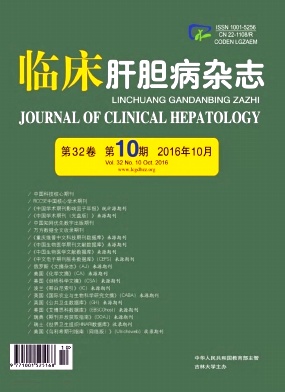|
[1]WANG JH,ZHAO ZQ,LUO DL,et al.Multislice CT diagnosis of rare liver tumors[J].Diagn Imag Interv Radiol,2014,23(3):220-223.(in Chinese)王建华,赵志清,罗帝林,等.肝脏少见肿瘤多层螺旋CT分析[J].影像诊断与介入放射学,2014,23(3):220-223.
|
|
[2]BLANC JF,FRULIO N,CHICHE L,et al.Hepatocellular adenoma management:call for shared guidelines and multidisciplinary approach[J].Clin Res Hepatol Gastroenterol,2015,39(2):180-187.
|
|
[3]KHANNA M,RAMANATHAN S,FASIH N,et al.Current updates on the molecular genetics and magnetic resonance imaging of focal nodular hyperplasia and hepatocellular adenoma[J].Insights Into Imaging,2015,6(3):347-362.
|
|
[4]BALABAUD C,AL-RABIH WR,CHEN PJ,et al.Focal nodular hyperplasia and hepatocellular adenoma around the world viewed through the scope of the immunopathological classification[J].Int J Hepatol,2013,2013:268625.
|
|
[5]CAPPELL MS.Hepatic disorders severely affected by pregnancy:medical and obstetric management[J].Med Clin North Am,2008,92(4):739-760.
|
|
[6]NAULT JC,BIOULAC-SAGE P,ZUCMAN-ROSSI J.Hepatocellular benign tumors-form molecular classificationto personalized clinical care[J].Gastroenterology,2013,144(5):888-902.
|
|
[7]BUNCHORNTAVAKUL C,BAHIRWANI R,DRAZEK D,et al.Clinical features and natural history of hepatocellular adenonas:the impact of obesity[J].Aliment Pharmacol Ther,2011,34(6):664-674.
|
|
[8]BIOULAC-SAGE P,TAOUJI S,POSSENTI L,et al.Hepatocellular adenoma subtypes:the impact of overweight and obesity[J].Liver Int,2012,32(8):1217-1221.
|
|
[9]van AALTEN SM,de MAN RA,IJZERMANS JN,et al.Systematic review of haemorrhage and rupture of hepatocellular adenomas[J].Br J Surg,2012,99(7):911-916.
|
|
[10]FARGES O,FERREIRA N,DOKMAK S,et al.Changing trends in malignant transformation of hepatocellular adenoma[J].Gut,2011,60(1):85-89.
|
|
[11]BIOULAC-SAGE P,SEMPOUX C,POSSENTI L,et al.Pathological diagnosis of hepatocellular cellular adenoma according to the clinical context[J].Int J Hepatol,2013,2013:253261-253261.
|
|
[12]ZHU XL,LIN Q.Status and advances in imaging diagnosis of hepatic adenoma[J].Int J Radiat Med,2011,35(2):124-127.(in Chinese)朱晓琳,林强.肝腺瘤的影像诊断现状及进展[J].国际放射医学核医学杂志,2011,35(2):124-127.
|
|
[13]SINGHI AD,JAIN D,KAKAR S,et al.Reticulin loss in benign fatty liver:an important diagnostic pitfall when considering a diagnosis of hepatocellular carcinoma[J].Am J Pathol,2012,36(5):710-715.
|
|
[14]GRAZIOLI L,OLIVETTI L,MAZZA G,et al.MR imaging of hepatocellular adenomas and differential diagnosis dilemma[J].Int J Hepatol,2013,2013:374170.
|
|
[15]FURLAN A,BORHANI AA,HELLER MT,et al.Non-focal liver signal abnormalities on hepatobiliary phase of gadoxetate disodium-enhanced MR imaging:a review and differential diagnosis[J].Abdom Radiol(NY),2016,41(7):1399-1410.
|
|
[16]FRANCISCO FA,de ARAU'JO AL,OLIVEIRA NETO JA,et al.Hepatobiliary contrast agents:differential diagnosis of focal hepatic lesions,pitfalls and other indications[J].Radiol Bras,2014,47(5):301-309.
|
|
[17]van AALTEN SM,THOMEER MG,TERKIVATAN T,et al.Hepatocellular adenomas:correlation of MR imaging findings with pathologic subtype classification[J].Radiology,2011,261(1):172-181.
|
|
[18]RONOT M,VILGRAIN V.Imaging of benign hepatocellular lesions:current concepts and recent updates[J].Clin Res Hepatol Gastroenterol,2014,38(6):681-688.
|
|
[19]AGARWAL S,FUENTES-ORREGO JM,ARNASON T,et al.Inflammatory hepatocellular adenomas can mimic focal nodular hyperplasia on gadoxetic acid-enhanced MRI[J].AJR Am J Roentgenol,2014,203(4):408-414.
|
|
[20]THOMEER MG,WILLEMSSEN FE,KATHARINA K,et al.MRI features of inflammatory hepatocellular adenomas on hepatocyte phase imaging with liver-specific contrast agents[J].J Magn Reson Imaging,2014,39(5):1259-1264.
|
|
[21]PAULETTE B,LAUMONIER H,COUCHY G,et al.Hepatocellular adenoma management and phenotypic classification:the bordeaux experience[J].Hepatology,2009,50(2):481-489..
|
|
[22]SHANBHOGUE A,SHAH SN,ZAHEERA,et al.Hepatocellular adenomas:current update on genetics,taxonomy,and management[J].J Comput Assist Tomogr,2011,35(2):159-166.
|
|
[23]SHII M,KAZAOKA J,FUKUSHIMA J,et al.A case of-catenin-positive hepatocellular adenoma with MR imaging sign of diffuse intratumoral fat deposition[J].Abdom Imaging,2015,40(6):1-5.
|
|
[24]NGUYEN TB,RONCALLI M,di TOMMASO L,et al.Combined use of heat-shock protein 70 and glutamine synthetase is useful in the distinction of typical hepatocellular adenoma from atypical hepatocellular neoplasms and well-differentiated hepatocellular carcinoma[J].Mod Pathol,2016,29(3):283-292.
|
|
[25]LI T,QIN LX,LIN GL,et al.Spontaneous rupture and bleeding of hepatic focal nodular hyperplasia:a case report[J].Chin J Gen Surg,2007,22(9):713-714.(in Chinese)李涛,钦伦秀,林国领,等.肝脏局灶性结节增生自发破裂出血一例[J].中华普通外科杂志,2007,22(9):713-714.
|
|
[26]HASHIMOTO K,TATSUMI N,SHIMIZU J,et al.Resected focal nodular hyperplasia that was difficult to differentiate from hepatocellular carcinoma-a case report[J].Gan To Kagaku Ryoho,2015,42(12):1869-1871.
|
|
[27]BIOULAC-SAGE P,REBOUISSOU S,THOMAS C,et al.Hepatocellular adenoma subtype classification using molecular markers and immunohistochemistry[J].Hepatology,2007,46(3):740-748.
|
|
[28]MORANA G,GRAZIOLI L,KIRCHIN MA,et al.Solid hypervascular liver lesions:accurate identification of true benign lesions on enhanced dynamic and hepatobiliary phase magnetic resonance imaging after gadobenate dimeglumine administration[J].Invest Radiol,2011,46(4):225-239.
|
|
[29] CHALLAGULLA K.Radiologic and pathological presentation of fibrolamellar hepatic carcinoma of liver[D].Jilin:Jilin University,2015.(in Chinese)CHALLAGULLA K.纤维板层型肝癌的影像学和病理表现[D].吉林:吉林大学,2015.
|
|
[30]RITA G,LUIGI G,EMANUELA O,et al.Which is the best MRI marker of malignancy for atypical cirrhotic nodules:hypointensity in hepatobiliary phase alone or combined with other features?Classification after Gd-EOB-DTPA administration[J].J Magn Reson Imaging,2012,36(3):648-657.
|
|
[31]TSUDA N,MATSUI O.Cirrhotic rat liver:reference to transporter activity and morphologic changes in bile canaliculi——gadoxetic acid-enhanced MR imaging[J].Radiology,2010,256(3):767-773.
|
|
[32]CARAIANI CN,DAN M,FENESAN DI,et al.Description of focal liver lesions with Gd-EOB-DTPA enhanced MRI[J].Clujul Medical,2015,88(4):438-448.
|
|
[33]CAMPOS JT,SIRLIN CB,CHOI JY.Focal hepatic lesions in GdGD-EOB-DTPA enhanced MRI:the atlas[J].Insights Imaging,2012,3(5):451-474.
|
|
[34]ALBIIN N.MRI of focal liver lesions[J].Curr Med Imaging Rev,2012,8(2):107-116.
|
|
[35]EL-BADRAWY A,ASHMALLAH GA,TAWFIK AM,et al.Diffusion-Weighted MR Imaging of the benign hepatic focal lesions[J].O J Rad,2014,4(1):136-143.
|









 本站查看
本站查看




 DownLoad:
DownLoad: